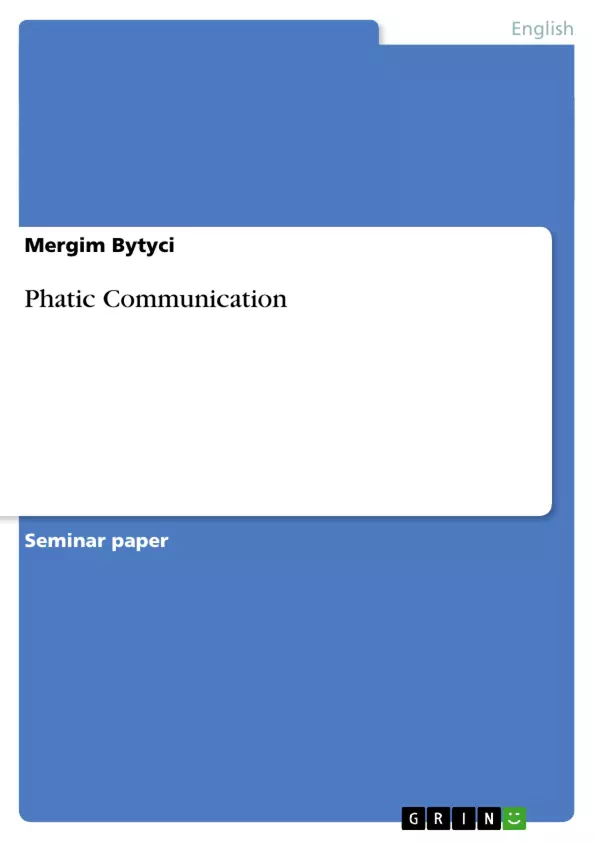Phatic Communication
What does it mean when someone asks ´How are you?` Usually the speaker expects to hear a response like ´I am fine, thank you. How are you?`, if he is trying to make ´chit-chat`.
It is assumed that all people are able to seize a distinction between chit-chat and the attempt to conduct a genuine conversation.
To make it easier to understand I will start with two conversations which I am going to analyze:
(1) Groundhog Day
ML: I hope you enjoy the festivities.
PC: Oh I´m sure I´m going to (pulls face).
ML: There´s there´s talk of a blizzard.
PC: Well, we may catch a break and that blizzard´s gonna blow right by us. All of this moisture coming up outta the south by midday is probably gonna push on to the east of us and at high altitudes it´s gonna crystallise and give us what we call snow. (winks) Probably be some accumulation. But here in Punxsutawney our high´s gonna get up to about 30 today, teens tonight, chance of precipitation about 20 per cent today 20 per cent tomorrow. Did you wanna talk about the weather or were you just making chit-chat?
ML: (shrugs and shakes head) Chit-chat.
PC: OK. Right. See you later. B´bye.
ML: Oh em eh will you be checking out today Mr. Connors?
PC: Chance of departure today one hundred per cent.
Obviously MC just wanted to make chit-chat what means that Connor´s detailed answer was inappropriate. Since he is doing this intentionally he could have reasons for his behaviour (e.g. he does not like chit-chat; he does not like MC).
The next example is a conversation between two real estate salesmen:
(2) Glengarry Glen Ross
RR: How are you
GA: Fine (,,) you mean on the board (,) you mean you mean you mean on the board
RR: I (,) yes (,) the board
GA: I’m fucked on the board
Speakers: RR = Ricky Roma; GA = George Aaronow.
Contextual assumptions:
Roma is very successful in contrast to Aaronow, which is a fact well-known to both since their performances are being recorded on the mentioned board in their office. Only the best two salesmen will keep their jobs while the others are about to get fired.
The question which arises is which utterance should be interpreted as phatic and which as non-phatic (if there is anything like that).
Referring to example (1) we can say that Mrs. Lancaster´s attempt to start a verbal exchange could be called phatic since she is trying to make contact with Connor. Connor´s dis-preferred response, however, can be considered as negatively phatic.
As mentioned above, i
Inhaltsverzeichnis (Table of Contents)
- Introduction
- Phatic Communication
- Manifestness
- Ostensive-Inferential Communication
- Intuitions
- Interpretations
- Degrees of Phaticness
- Small Talk
- Conversational Storytelling
- Conclusion
Zielsetzung und Themenschwerpunkte (Objectives and Key Themes)
This paper explores the nature of Phatic Communication and its production, drawing on the work of Vlad Zegarac and Billy Clark, who connect this type of communication with Relevance Theory. It examines how phatic interpretations involve cognitive processes and challenges the traditional view of phatic communication solely as a social phenomenon. The paper aims to analyze the insights of Zegarac and Clark and apply them to conversational contexts.
- Phatic Communication and its relationship to Relevance Theory
- The role of cognitive processes in phatic interpretations
- The distinction between phatic and non-phatic communication
- The concept of ostensive-inferential communication and its role in phatic exchanges
- The significance of manifestness and the Shared Cognitive Environment in phatic communication
Zusammenfassung der Kapitel (Chapter Summaries)
The paper begins by introducing the concept of Phatic Communication, using examples from real-life conversations to illustrate the distinction between chit-chat and genuine conversation. It then explores Zegarac and Clark's argument that phatic communication involves cognitive processes and requires an understanding of Relevance Theory. The chapter delves into the concept of ostensive-inferential communication, explaining how it involves both an ostensive act of communication and an inferential process by the hearer. The significance of manifestness and the Shared Cognitive Environment in understanding phatic communication is also discussed.
Schlüsselwörter (Keywords)
This paper focuses on key concepts such as Phatic Communication, Relevance Theory, ostensive-inferential communication, manifestness, Shared Cognitive Environment, and cognitive processes. It explores the interplay between these concepts in the context of conversational analysis, aiming to provide a deeper understanding of phatic communication beyond its traditional social interpretation.
- Arbeit zitieren
- Mergim Bytyci (Autor:in), 2009, Phatic Communication, München, GRIN Verlag, https://www.grin.com/document/134706



